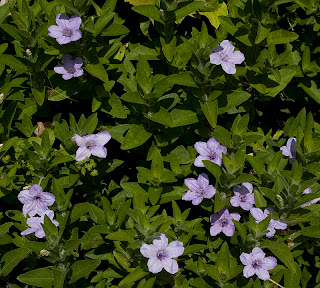
Dragonflies and damselflies (together comprising the order Ordonata) make up one of those classes of living things that I see all the time but have paid little attention to, at least beyond noting them flying about and the different colors of their wings. So because they are quite abundant around here this month, I decided to take a closer look. A single trip around the bottom field path figuratively netted three very different species, two dragonflies and one damselfly. It was easy to identify the guy to the left here as a damselfly, because he is holding his wings folded high when stationary, while dragonflies sit with their wings stretched out. Damselflies tend also to be distinguishable from dragonflies by their lacy, fluttering style of flight. This is a quite colorful example (probably because he's in the sun) of an ebony jewelwing (
Calopteryx maculata).
I'm no dragonfly biologist, let alone a card carrying member of the International Odonatological Society, so please correct me, but using James R. Curry's beautiful and informative book
Dragonflies of Indiana,

I have tentatively identified the dragonfly below as a female blue dasher (
Pachydiplax longipennis). Note the stretched and slightly downfolded wings, the white face, eyes close together and double row of yellow markings on the abdomen.
Dragonflies are amazing. Their larval stage is spent under water for a year or more, after which they emerge and go through a metamorphosis for a brief but frenzied few days or weeks as a flying adult, focused exclusively on eating and mating. And dragonflies are big eaters, they can consume their weight in flies and mosquitoes in an hour. Their compound eyes are composed of as many as 30,000 individual lenses each, and it is a testament to the wonder of life that their small, literally pin-head size brain can both coordinate their beautiful and intentional movements as well as interpret the rapidly changing visual scene in order to hunt prey and find a mate. Although some dragonflies get along almost anywhere near water, many species are adapted to very specific environments. This is another reason to conserve, recreate, or manage the specific habitats we find ourselves living in.
Finally, as an aside, I was reminded by the blue dasher image of why I like to take photographs. Click on her image immediately above to open a full resolution image in a separate browser window. OK, sure, taking pictures is something I can actually do. But it ends up as both a motivation and a path to examining the natural world. Examining almost any photograph (yes, sometimes even family snapshots) can reveal startling, unexpected, and beautiful details that aren't available in "real time," and force you to consider the differences, the commonalities, the "something new" present in those details. As stated above, I had never thought much about dragonflies, never having had the opportunity to look at them in the way we can look at butterflies or even birds, let alone a tree or blade of grass. But these images do something extra for me beyond the also enjoyable walk in the woods, and I hope they do for you as well.
 (published 1915) I found and quote this interesting information about the use of the flower.
(published 1915) I found and quote this interesting information about the use of the flower.



















